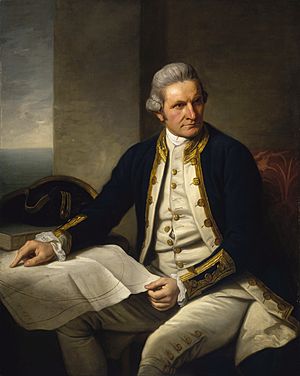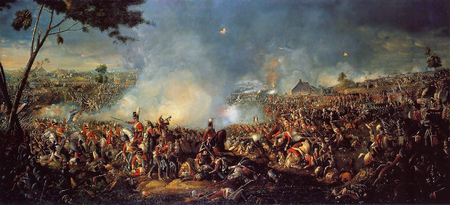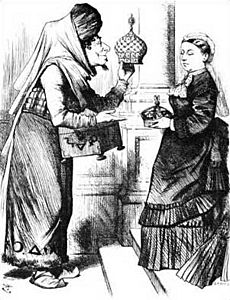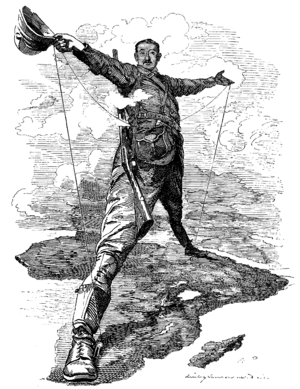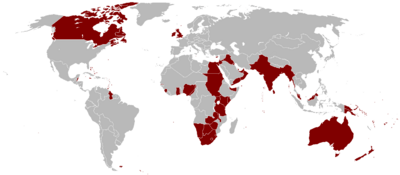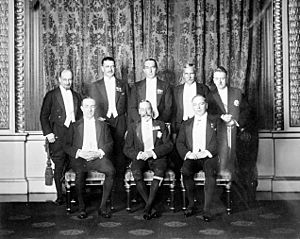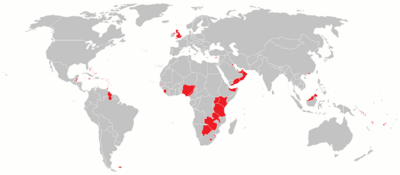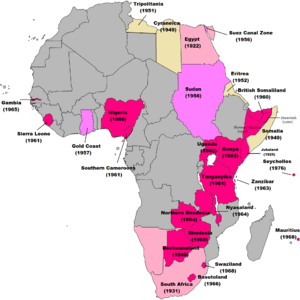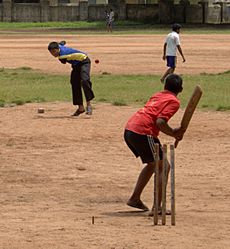British Empire facts for kids
Quick facts for kids
British Empire
|
|
|---|---|
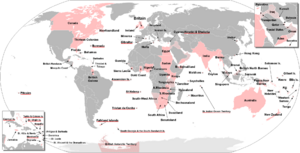
Areas of the world that were part of the British Empire with current British Overseas Territories underlined in red. Mandates and protected states are shown in a lighter shade.
|
The British Empire was a huge collection of lands and countries ruled or controlled by the United Kingdom. It started in the late 1500s and early 1600s when England began setting up colonies and trading posts overseas. At its biggest, in the 19th and early 20th centuries, it was the largest empire ever.
By 1913, about 412 million people lived in the British Empire. This was about a quarter of the world's population at that time. By 1920, the empire covered about 35.5 million square kilometers. This was about a quarter of Earth's total land area. Because of this, the English language, laws, and culture spread widely. People often said, "the empire on which the sun never sets". This meant the sun was always shining on at least one part of the empire.
In the 15th and 16th centuries, Portugal and Spain were the first European countries to explore the world. They built large empires. England, France, and the Netherlands wanted to be rich too. So, they started their own colonies and trade networks in the Americas and Asia. After many wars in the 17th and 18th centuries, Britain became the main colonial power. This was especially true in North America. Britain also became very powerful in India after the East India Company won the Battle of Plassey in 1757.
Britain lost some of its oldest colonies in North America after the American Revolutionary War in 1783. These colonies became the United States. Britain still controlled British North America (now Canada) and islands in the Caribbean. After this, Britain focused on expanding its empire in Asia, Africa, and the Pacific. After the Napoleonic Wars (1803–1815), Britain became the strongest naval and imperial power. It gained more lands and controlled much of the world's trade. This time of peace and British power was called Pax Britannica ("British Peace").
By the early 1900s, Germany and the United States started to challenge Britain's power. Tensions between Britain and Germany led to the First World War. The war put a huge strain on the empire. Even though the empire grew even bigger after the war, Britain was no longer the world's top industrial or military power.
In the Second World War, Japan took over British colonies in East and Southeast Asia. After the war, Britain's power weakened. India, its most important colony, gained independence in 1947. This was part of a larger movement where many colonies became independent. The Suez Crisis in 1956 showed that Britain was no longer a major global power. The return of Hong Kong to China in 1997 is often seen as the end of the British Empire. Today, 14 British Overseas Territories are still under British rule. Many former colonies joined the Commonwealth of Nations. This is a group of independent countries. Fifteen of these countries, including the UK, still have King Charles III as their monarch.
Contents
- How the British Empire Began (1497–1583)
- Early English Colonies (1583–1707)
- Scotland's Attempt to Expand Overseas
- The "First" British Empire Grows (1707–1783)
- The "Second" British Empire Rises (1783–1815)
- Britain's Imperial Century (1815–1914)
- World Wars (1914–1945)
- End of the Empire (1945–1997)
- Legacy of the British Empire
- See also
How the British Empire Began (1497–1583)
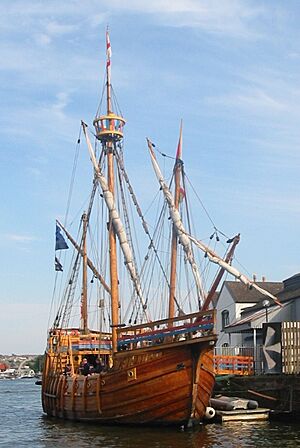
The British Empire started when England and Scotland were separate kingdoms. In 1496, King Henry VII of England wanted to find a new sea route to Asia. He sent John Cabot on an expedition. Cabot sailed in 1497, five years after Christopher Columbus's first trip. He landed in Newfoundland. He thought he had reached Asia. No colony was started there. Cabot went on another trip the next year but never returned.
England did not try to set up colonies in the Americas again until the late 1500s. This was during the time of Queen Elizabeth I. England became enemies with Catholic Spain. Queen Elizabeth I encouraged sailors like John Hawkins and Francis Drake to attack Spanish and Portuguese ships. They also raided Spanish ports in the Americas. These ships were full of treasure from the New World.
At the same time, important writers like Richard Hakluyt and John Dee (who first used the term "British Empire") pushed for England to build its own empire. By then, Spain was powerful in the Americas. Portugal had trading posts in Africa, Brazil, and China. France had started to settle in Canada.
England was behind Portugal, Spain, and France in setting up colonies overseas. But it did start colonizing parts of Ireland in the 1500s. English and Welsh Protestant settlers moved there. Some people who helped with these settlements later helped start colonies in North America.
Early English Colonies (1583–1707)
In 1578, Queen Elizabeth I gave Humphrey Gilbert permission to explore and discover new lands. He tried to set up a colony in North America, but it failed. In 1583, he tried again. He claimed the harbor of Newfoundland, but no settlers stayed there. Gilbert died on his way back to England. His half-brother, Walter Raleigh, took over. In 1584, Raleigh started the Roanoke Colony in present-day North Carolina. But it failed because of a lack of supplies.
In 1603, James VI of Scotland became King James I of England. In 1604, he made peace with Spain. England then focused on building its own colonies. The British Empire began to grow in the early 1600s. English people settled in North America and the Caribbean islands. Companies like the East India Company were formed to manage colonies and trade. This period, until Britain lost the Thirteen Colonies in the late 1700s, is sometimes called the "First British Empire."
Colonies in the Americas and the Slave Trade
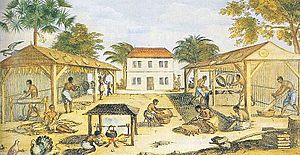
England's first attempts to colonize the Americas had mixed results. A colony in British Guiana in 1604 failed after two years. Colonies on Saint Lucia (1605) and Grenada (1609) also failed quickly. The first lasting English settlement in the Americas was Jamestown, founded in 1607. The King took control of it in 1624, creating the Colony of Virginia.
Many English people came to America to escape religious persecution. Plymouth was founded in 1620 by Puritans. Maryland was for English Roman Catholics (1634). Rhode Island (1636) allowed all religions. Connecticut (1639) was for Congregationalists. England also took the Dutch colony of New Netherland in 1664. It was renamed New York. These North American lands had good farmland and attracted many English settlers.
The British West Indies (Caribbean islands) became England's most important and profitable colonies. Settlements started in Saint Kitts (1624), Barbados (1627), and Nevis (1628). These islands became very rich from sugar plantations in the mid-1600s. At first, white workers were used. But soon, English traders started using enslaved Africans. The huge wealth from sugar made Barbados one of the richest places in the world. This led to more sugar farming and the growth of the Atlantic slave trade. This trade involved slaves, sugar, and goods moving between Africa, the West Indies, and Europe.
To keep trade profits in English hands, Parliament said in 1651 that only English ships could trade with English colonies. This led to wars with the Dutch, which helped England's power in the Americas. In 1655, England took Jamaica from Spain. In 1666, it colonized the Bahamas.
In 1670, King Charles II of England gave the Hudson's Bay Company (HBC) control over the fur trade in Rupert's Land. This area later became a big part of Canada. French forces often attacked HBC forts.
In 1672, the Royal African Company gained control of supplying slaves to British colonies. This company transported more slaves than any other. It greatly increased England's share of the slave trade. From 1688 to 1712, other British slave traders joined in. British ships carried about 3.5 million Africans across the Atlantic. This was a third of all slaves transported. The slave trade was abolished by Parliament in 1807. To help with slave shipments, forts were built on the coast of West Africa. These included James Island and Bunce Island.
In the British Caribbean, the number of people of African descent grew from 25% in 1650 to about 80% in 1780. In the Thirteen Colonies, it grew from 10% to 40%. The slave trade was a huge part of British economic life. It made port cities like Bristol, Liverpool, and London very rich. Conditions on slave ships were terrible. About one in seven enslaved people died during the journey.
Competing with Other European Empires

In the late 1500s, England and the Dutch Empire started to challenge Portugal's control of trade with Asia. They formed companies to fund voyages. These were the English (later British) East India Company (1600) and the Dutch East India Company (1602). Their main goal was to get rich from the spice trade. They focused on the Malay Archipelago and India. They competed with Portugal and each other.
Even though England later became a stronger colonial power, the Netherlands had a better financial system. They also fought three Anglo-Dutch Wars in the 1600s. This gave the Netherlands a stronger position in Asia for a while. Fighting stopped after 1688 when the Dutch William of Orange became King of England. This brought peace between the two countries. They agreed that the Netherlands would control the spice trade, and England would control the textile industry in India. Textiles soon became more profitable than spices.
Peace with the Netherlands meant England and the Dutch became allies in the Nine Years' War. This war was fought in Europe and overseas. It involved France, Spain, and the Anglo-Dutch alliance. England became a stronger colonial power than the Dutch. The Dutch had to spend more money on the war in Europe.
In 1700, Charles II of Spain died. He left Spain and its empire to Philip V of Spain, the French King's grandson. This raised fears that France and Spain would unite their empires. This was unacceptable to England and other European powers. In 1701, England, Portugal, and the Netherlands joined forces against Spain and France in the War of the Spanish Succession. This war lasted 13 years.
Scotland's Attempt to Expand Overseas
In 1695, the Parliament of Scotland allowed the Company of Scotland to set up a settlement. In 1698, they started a colony on the Isthmus of Panama. Spanish colonists and diseases like malaria attacked the colony. It was abandoned two years later. This "Darien scheme" was a huge financial disaster for Scotland. A quarter of Scotland's money was lost. This event had big political effects. It helped convince Scotland's government to unite with England. This led to the Kingdom of Great Britain in 1707.
The "First" British Empire Grows (1707–1783)
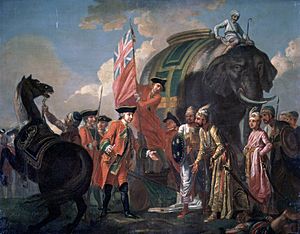
The 18th century saw the newly united Great Britain become the world's leading colonial power. France was its main rival. The War of the Spanish Succession ended in 1714 with the Treaty of Utrecht. Philip V of Spain gave up his claim to the French throne. Spain lost its empire in Europe. The British Empire grew bigger. Britain gained Newfoundland and Acadia from France. It gained Gibraltar and Menorca from Spain. Gibraltar became a very important naval base. It allowed Britain to control the entrance to the Mediterranean Sea. Spain also gave Britain the right to sell African slaves in Spanish America.
In 1739, the War of Jenkins' Ear started with Spain. Spanish ships attacked British merchant ships. In 1750, Britain lost its slave-trading rights in Latin America.
In India, British and Dutch traders still competed. But by 1720, the British East India Company was selling more textiles than the Dutch. In the mid-1700s, there were many wars in India. The English East India Company and the French East India Company fought alongside local rulers. They wanted to fill the power gap left by the falling Mughal Empire. The Battle of Plassey in 1757 was a big win for the British. They defeated the ruler of Bengal and his French allies. This gave the British East India Company control of Bengal. It became a major military and political power in India. France kept some small areas but lost its hopes of controlling India. In the next decades, the British East India Company took control of more and more land in India. They ruled directly or through local leaders. Most of their army was made up of Indian soldiers called sepoys, led by British officers.
The British and French struggles in India were part of the larger Seven Years' War (1756–1763). This war involved France, Britain, and other major European powers. The Treaty of Paris (1763) had big effects on the British Empire. In North America, France lost its power. Britain gained control of Rupert's Land and New France (now Canada). Spain gave Florida to Britain. After winning against France in India and North America, Britain became the world's strongest naval power.
Losing the Thirteen American Colonies
During the 1760s and early 1770s, relations between the Thirteen Colonies and Britain became difficult. The colonists were angry that the British Parliament tried to tax them without their agreement. Their slogan was "No taxation without representation". This meant they felt their rights were being ignored. The American Revolution began when the colonies rejected British rule. Britain sent troops to take back control, leading to war in 1775.
In 1776, the colonies declared their independence. They became the United States of America. France and Spain joined the war to help the Americans. This turned the tide against Britain. After a big defeat at Yorktown in 1781, Britain started peace talks. American independence was officially recognized in 1783.
Losing such a large part of its empire, the Thirteen Colonies, was a big moment for Britain. Some historians see it as the shift from the "first" to the "second" empire. Britain then focused on Asia, the Pacific, and later Africa. Adam Smith's book The Wealth of Nations, published in 1776, argued that colonies were not needed. He said that free trade was better than the old system of controlling trade. The growth of trade between the new United States and Britain after 1783 seemed to prove his point.
The war also affected British policy in Canada. Many Loyalists (people loyal to Britain) moved to Canada from the United States. In 1784, New Brunswick was made a separate colony. The Constitutional Act of 1791 created Upper Canada (English-speaking) and Lower Canada (French-speaking). This was to ease tensions and keep British control.
Tensions between Britain and the United States grew again during the Napoleonic Wars. Britain tried to stop American trade with France. It also forced American sailors to join the Royal Navy. The United States declared war in 1812 and invaded Canada. Britain invaded the US in return. But the war ended in 1814 with the same borders as before. This ensured Canada's future was separate from the United States.
The "Second" British Empire Rises (1783–1815)
Exploring the Pacific
Since 1718, Britain had sent criminals to its American colonies as punishment. After losing the Thirteen Colonies in 1783, Britain needed a new place. It turned to Australia. The Dutch had seen Australia's coast in 1606, but no one tried to colonize it. In 1770, James Cook mapped the eastern coast. He claimed it for Britain and named it New South Wales. In 1778, Joseph Banks, Cook's botanist, suggested Botany Bay for a penal settlement. The first group of convicts arrived in 1788.
Australia was claimed by simply saying it was British. The Indigenous Australians were not seen as needing treaties. Colonization brought disease and violence. It also took away their land and culture. Britain continued to send convicts to New South Wales until 1840, to Tasmania until 1853, and to Western Australia until 1868. The Australian colonies became rich from exporting wool and gold. The Victorian gold rush made Melbourne the richest city in the world for a time.
During his voyage, Cook also visited New Zealand. The Dutch explorer Abel Tasman had seen it in 1642. Cook claimed both the North Island and the South Island for Britain in 1769 and 1770. At first, the native Maori traded with European settlers. More Europeans settled there in the early 1800s. Many trading posts were set up, especially in the North. In 1839, the New Zealand Company planned to buy large areas of land. On February 6, 1840, Captain William Hobson and about 40 Maori chiefs signed the Treaty of Waitangi. This is seen as New Zealand's founding document. However, there are still disagreements about the Maori and English versions of the text.
The British also expanded their trade in the North Pacific. Spain and Britain competed there, leading to the Nootka Crisis in 1789. Both sides prepared for war. But France refused to support Spain, so Spain backed down. This opened the way for British expansion. Expeditions like George Vancouver's explored the coast. On land, explorers looked for a river route to the Pacific for the fur trade. Alexander Mackenzie was the first European to reach the Pacific overland north of the Rio Grande in 1793. This was 12 years before the Lewis and Clark Expedition. Soon after, the first permanent European settlement in British Columbia was founded.
More Conquests in India
The East India Company fought several wars in Southern India. These were the Anglo-Mysore Wars against the Sultanate of Mysore. After victories in the Third and Fourth wars, the kingdom became a protectorate of the company.
The East India Company also fought three wars with the Maratha Confederacy. The first war ended with no change. The second and third wars resulted in British victories. After 1818, the East India Company controlled most of India.
Wars with France
Britain faced another challenge from France under Napoleon. This was a war of ideas. Napoleon threatened to invade Britain itself. The Napoleonic Wars were very costly for Britain. The Royal Navy blocked French ports. It won a big victory at the Battle of Trafalgar in 1805. British forces attacked and took over overseas colonies, including those of the Netherlands. France was finally defeated by European armies in 1815.
Britain gained more land from peace treaties. France gave up the Ionian Islands, Malta, Mauritius, St Lucia, the Seychelles, and Tobago. Spain gave up Trinidad. The Netherlands gave up Guiana, Ceylon, and the Cape Colony. Denmark gave up Heligoland. Britain returned some lands to France, Spain, Denmark, and the Netherlands.
Ending Slavery
With the Industrial Revolution, goods made by enslaved people became less important to Britain. Also, it was costly to stop slave rebellions. The British abolitionist movement pushed for change. In 1807, Parliament passed the Slave Trade Act 1807. This law ended the slave trade in the empire. In 1808, Sierra Leone Colony became a British colony for freed slaves.
In 1833, the Slavery Abolition Act 1833 was passed. It ended slavery in the British Empire on August 1, 1834. This brought the empire's laws in line with the UK. Enslaved people were given full freedom after a few years of "apprenticeship." This system was ended in 1838. The British government paid money to slave owners.
Britain's Imperial Century (1815–1914)
Between 1815 and 1914, the British Empire grew greatly. About 26 million square kilometers of land and 400 million people were added. After defeating Napoleon, Britain had no major international rivals except Russia in Central Asia. Britain was unmatched at sea. It became the world's policeman, a time known as the Pax Britannica. Britain also followed a policy of "splendid isolation". This meant it avoided alliances with other European powers.
Besides ruling its colonies, Britain controlled the economies of many countries. This was due to its dominance in world trade. This control is sometimes called an "Informal Empire". New technologies like the steamship and the telegraph helped Britain control and defend its empire. By 1902, a network of telegraph cables, called the All Red Line, connected the entire British Empire.
The East India Company in Asia
The East India Company led the expansion of the British Empire in Asia. The Company's army worked with the Royal Navy. They fought together to remove the French from Egypt (1799). They also captured Java from the Netherlands (1811). They gained Penang Island (1786), Singapore (1819), and Malacca (1824). They also defeated Burma (1826).
From its base in India, the Company also traded opium to China. This trade was very profitable since the 1730s. It was illegal in China. But it helped balance trade because Britain bought a lot of tea from China. In 1839, Chinese officials took 20,000 chests of opium. This led Britain to attack China in the First Opium War. Britain took Hong Kong Island, which was a small settlement then.
In the late 1700s and early 1800s, the British Crown took more control over the Company. Parliament passed laws to regulate the Company and give the Crown power over its lands. The Company's end came after the Indian Rebellion of 1857. This conflict started with a mutiny of Indian soldiers. It took six months to stop the rebellion. Many lives were lost. The next year, the British government took direct control of India. This created the British Raj. An appointed governor-general ruled India, and Queen Victoria became the Empress of India. India became the empire's most valuable possession, known as "the Jewel in the Crown."
In the late 1800s, many crop failures led to severe famines in India. Over 15 million people died. The East India Company had not done enough to deal with famines. Under direct British rule, new policies were put in place. These policies started to help by the early 1900s.
Competing with Russia
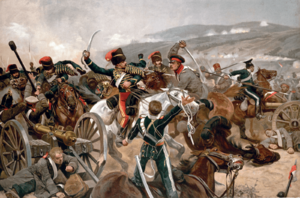
In the 19th century, Britain and the Russian Empire competed for power. This was in areas left weak by the falling Ottoman, Qajar, and Qing empires. This rivalry in Central Asia was called the "Great Game". Britain worried that Russia's victories over Persia and Turkey meant Russia wanted to invade India. In 1839, Britain tried to stop this by invading Afghanistan. But the First Anglo-Afghan War was a disaster for Britain.
In 1853, Russia invaded the Turkish Balkans. Britain and France worried about Russia's power in the Mediterranean and Middle East. They invaded the Crimean Peninsula to weaken Russia's navy. The Crimean War (1854–56) used new war techniques. It was a big defeat for Russia.
The situation in Central Asia remained tense for two more decades. Britain took Baluchistan in 1876. Russia took Kirghizia, Kazakhstan, and Turkmenistan. It seemed another war was coming. But the two countries agreed on their areas of influence in 1878. They settled all other issues in 1907. Japan's defeat of the Russian Navy in 1904–05 also reduced Russia's threat to Britain.
From Cape to Cairo
The Dutch East India Company had started the Cape Colony in southern Africa in 1652. It was a stop for ships going to and from Asia. Britain officially took the colony in 1806. It had a large Afrikaner (or Boer) population. British immigration increased after 1820. Many Boers, unhappy with British rule, moved north. They founded their own independent republics. This was called the Great Trek. The Boers often clashed with the British. The British wanted to expand their colonies in South Africa. The Boers eventually set up two lasting republics: the South African Republic and the Orange Free State. In 1902, Britain took over both republics after the Second Boer War (1899–1902).
In 1869, the Suez Canal opened. It connected the Mediterranean Sea with the Indian Ocean. Britain first opposed the Canal. But once it opened, its importance was clear. It became the "jugular vein of the Empire." In 1875, the British government bought the Egyptian ruler's share in the Suez Canal. This gave Britain influence over the Canal. Joint Anglo-French control over Egypt led to Britain taking full control in 1882. The French tried to weaken Britain's position. But they reached an agreement in 1888. The Canal became officially neutral.
Other European countries like France, Belgium, and Portugal were also active in Africa. To manage this competition, the Berlin Conference was held in 1884–85. It set rules for claiming land in Africa. This period was called the "Scramble for Africa". Britain decided to return to Sudan in 1896. British and Egyptian troops defeated the Mahdist Army. They also stopped a French invasion in 1898. Sudan became a British colony in all but name.
British gains in Southern and East Africa inspired Cecil Rhodes. He was a key figure in British expansion in Southern Africa. He wanted a "Cape to Cairo" railway. This would connect the Suez Canal to the mineral-rich south. In the 1880s and 1890s, Rhodes's company took over lands. These lands were later named Rhodesia after him.
Changing Status of White Colonies
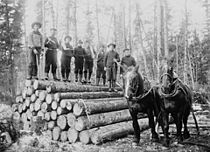
The white colonies of the British Empire started on their path to independence. This began with the 1839 Durham Report. It suggested uniting and giving self-government to Upper Canada and Lower Canada. This was to solve political problems. The Act of Union 1840 created the Province of Canada.
Responsible government was first given to Nova Scotia in 1848. It soon spread to other British North American colonies. In 1867, the British North America Act, 1867 created the Dominion of Canada. This was a group of self-governing provinces. They had full self-government except for international relations. Australia and New Zealand gained similar self-government after 1900. The Australian colonies united in 1901. The term "dominion status" was officially used in 1907.
In the late 1800s, there were strong campaigns for Irish home rule. Ireland had joined Britain to form the United Kingdom in 1801. It had suffered a terrible famine between 1845 and 1852. British Prime Minister William Ewart Gladstone supported home rule. He hoped Ireland would become a Dominion like Canada. But his bill was defeated in Parliament. Many feared that an independent Ireland could be a security threat. A second bill also failed. A third bill passed in 1914 but was not put into action because of the First World War. This led to the 1916 Easter Rising.
World Wars (1914–1945)
By the early 1900s, Britain worried it could not defend its empire and homeland alone. Germany was quickly growing as a military and industrial power. It was seen as the most likely enemy. Britain formed alliances with Japan in 1902, and with France and Russia in 1904 and 1907.
The First World War
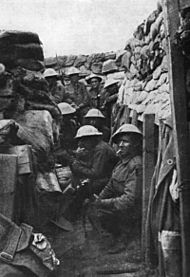
Britain's fears of war with Germany came true in 1914. The First World War began. Britain quickly invaded and took over most of Germany's colonies in Africa. In the Pacific, Australia and New Zealand took over German lands. Britain and France secretly planned to divide the Ottoman Empire, which had joined Germany. This plan was not told to the Sharif of Mecca. The British had encouraged him to start an Arab revolt against the Ottomans. They gave the impression Britain supported an independent Arab state.
When Britain declared war, its colonies and Dominions were also committed. They provided huge military, financial, and material support. Over 2.5 million men from the Dominions served. Many thousands of volunteers came from the Crown colonies. The help from Australian and New Zealand troops in the 1915 Gallipoli Campaign had a big impact. It marked a turning point for Australia and New Zealand. They began to see themselves as nations. These countries still remember this day as ANZAC Day. Canadians felt the same about the Battle of Vimy Ridge. The British Prime Minister David Lloyd George recognized the Dominions' important help. In 1917, he invited their Prime Ministers to join an Imperial War Cabinet.
After the war, the Treaty of Versailles was signed in 1919. The empire reached its largest size. It gained about 4.6 million square kilometers and 13 million new people. Germany's and the Ottoman Empire's colonies were given to the Allied powers as mandates. Britain gained control of Palestine, Transjordan, Iraq, parts of Cameroon and Togoland, and Tanganyika. The Dominions also received mandates. South Africa gained South West Africa (now Namibia). Australia gained New Guinea. New Zealand gained Western Samoa. Nauru became a shared mandate.
Between the World Wars
The First World War changed the world. The United States and Japan grew as naval powers. Independence movements rose in India and Ireland. This made Britain rethink its empire policy. Britain chose to align with the United States. It did not renew its alliance with Japan. Instead, it signed the 1922 Washington Naval Treaty. Britain agreed to have a navy equal to the United States. This decision was debated in Britain in the 1930s. People worried the empire could not survive attacks from both Japan and Germany. The empire's security was vital for Britain's economy.
In 1919, delays in Irish home rule caused frustration. Irish MPs who wanted independence formed their own parliament in Dublin. They declared Irish independence. The Irish Republican Army started a war against British rule. The Irish War of Independence ended in 1921. The Anglo-Irish Treaty created the Irish Free State. It was a Dominion within the British Empire. It had internal independence but was still linked to the British Crown. Northern Ireland chose to stay part of the United Kingdom.
A similar struggle happened in India. The Government of India Act 1919 did not satisfy demands for independence. War-time rules were renewed, leading to tension. This resulted in the Amritsar Massacre. Public opinion in Britain was divided. Some saw it as saving India from chaos. Others were horrified. The Non-cooperation movement was called off in 1922. Discontent continued for 25 years.
In 1922, Egypt, a British protectorate, gained formal independence. But it remained a British client state until 1954. British troops stayed in Egypt until 1936. They agreed to withdraw but would still defend the Suez Canal zone. Egypt then joined the League of Nations. Iraq, a British mandate since 1920, also gained independence in 1932.
In Palestine, Britain had to deal with Arabs and a growing number of Jews. Many Jewish refugees sought entry after the Holocaust. Arabs opposed a Jewish state. Britain announced in 1947 it would withdraw in 1948. It left the problem to the United Nations. The UN voted to divide Palestine into a Jewish and an Arab state.
The Dominions gained the right to set their own foreign policy in 1923. Britain asked for military help from the Dominions in 1922. Canada and South Africa refused. In 1926, the Balfour Declaration of 1926 stated that Dominions were "autonomous Communities within the British Empire, equal in status." This was made legal by the Statute of Westminster 1931. The parliaments of Canada, Australia, New Zealand, South Africa, the Irish Free State, and Newfoundland became independent of British law. Newfoundland returned to colonial status in 1933 due to financial problems. The Irish Free State moved further from Britain in 1937. It became a republic in all but name.
The Second World War
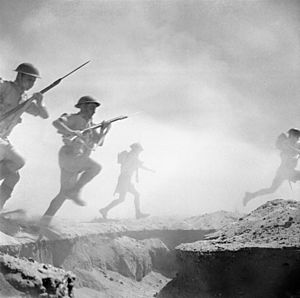
Britain declared war on Nazi Germany in September 1939. This included the Crown colonies and India. But it did not automatically include the Dominions. Australia, Canada, New Zealand, Newfoundland, and South Africa soon declared war. The Irish Free State chose to remain neutral.
After France was occupied by Germany in 1940, Britain and its empire stood alone. This was until the Soviet Union joined the war in 1941. British Prime Minister Winston Churchill got military aid from the United States. In August 1941, Churchill and President Franklin D. Roosevelt signed the Atlantic Charter. It said that "all peoples" should choose their own government. This wording was unclear. It could mean European countries or colonies. This led to different interpretations later.
In December 1941, Japan attacked British Malaya, Pearl Harbor, and Hong Kong. Churchill believed Britain would win with the US joining the war. But the quick defeats of British forces in the Far East greatly damaged Britain's image. The fall of Singapore was especially damaging. It had been called an unbeatable fortress. This showed Australia and New Zealand that Britain could not defend its whole empire. They formed closer ties with the United States. This led to the 1951 ANZUS Pact.
End of the Empire (1945–1997)
Britain and its empire won the Second World War. But the war had deep effects. Much of Europe was destroyed. The United States and the Soviet Union became the new global powers. Britain was nearly bankrupt. It only avoided collapse in 1946 with a large loan from the United States. Anti-colonial movements grew in European colonies. The Cold War also complicated things. Both the US and the Soviet Union were against European colonialism. But the US supported the British Empire to stop Communist expansion.
The "wind of change" meant the British Empire's days were ending. Britain generally chose to peacefully leave its colonies. This was different from France and Portugal, who fought costly wars to keep their empires. Between 1945 and 1965, the number of people under British rule outside the UK fell from 700 million to five million. Three million of these were in Hong Kong.
First Steps to Independence

The Labour government, elected in 1945, quickly addressed Indian independence. India's two main parties, the Indian National Congress and the Muslim League, wanted independence. But they disagreed on how. Congress wanted a unified state. The League wanted a separate Muslim state. Growing unrest and a navy mutiny in 1946 led to a promise of independence by June 1948. The last Viceroy, Lord Mountbatten, moved the date to August 15, 1947.
The British divided India into Hindu and Muslim areas. This left millions as minorities in the new states of India and Pakistan. Millions of Muslims moved to Pakistan, and Hindus moved to India. Violence between the groups killed hundreds of thousands. Burma and Sri Lanka gained independence in 1948. India, Pakistan, and Sri Lanka joined the Commonwealth of Nations. Burma did not.
The British mandate in Palestine had a similar problem. An Arab majority lived with a Jewish minority. Many Jewish refugees sought entry after the Holocaust. Arabs opposed a Jewish state. Britain, frustrated by the conflict, announced in 1947 it would withdraw in 1948. It left the issue to the United Nations. The UN voted to divide Palestine into a Jewish and an Arab state.
After Japan's defeat in the Second World War, anti-Japanese groups in Malaya turned against the British. Britain wanted to quickly retake control of Malaya for its rubber and tin. The guerrillas were mostly Chinese Communists. So, the Muslim Malay majority supported Britain. They understood that independence would be granted after the uprising. The Malayan Emergency lasted from 1948 to 1960. But by 1957, Britain granted independence to the Federation of Malaya. In 1963, 11 states, Singapore, Sarawak, and North Borneo formed Malaysia. But in 1965, Singapore left the union due to tensions. Brunei remained a British protectorate until its independence in 1984.
The Suez Crisis and Its Aftermath

In 1951, the Conservative Party returned to power in Britain. Winston Churchill was Prime Minister. He believed Britain's power depended on the empire. The base at the Suez Canal was key to its position in the Middle East. But Churchill had to deal with Gamal Abdel Nasser's new government in Egypt. In 1953, Britain agreed to withdraw troops from the Suez Canal zone. Sudan would gain self-rule by 1955, then independence. Sudan became independent on January 1, 1956.
In July 1956, Nasser took control of the Suez Canal. Anthony Eden, the new Prime Minister, secretly worked with France. They planned an Israeli attack on Egypt. This would give Britain and France an excuse to intervene and retake the canal. Eden angered US President Dwight D. Eisenhower by not consulting him. Eisenhower refused to support the invasion. He also worried about a wider war with the Soviet Union. Eisenhower used financial pressure. He threatened to sell US holdings of the British pound. This would cause the British currency to collapse.
Even though the invasion was a military success, UN intervention and US pressure forced Britain to withdraw. Eden resigned. The Suez Crisis clearly showed Britain's limits. It confirmed Britain's decline as a world power. It showed Britain could no longer act without US approval. The events at Suez hurt British pride. One MP called it "Britain's Waterloo." Margaret Thatcher later said it caused "Suez syndrome." This was a belief that Britain could do nothing. Britain did not recover until it retook the Falkland Islands in 1982.
British power in the Middle East weakened but did not collapse. Britain sent its forces to the region again. It intervened in Oman (1957), Jordan (1958), and Kuwait (1961). This time, it had American approval. The new Prime Minister Harold Macmillan wanted to stay close to the US. Britain kept a military presence in the Middle East for another decade. In 1968, Prime Minister Harold Wilson announced that British troops would leave major bases East of Suez. This included the Middle East, Malaysia, and Singapore. They would leave by the end of 1971. Britain withdrew from Aden in 1967, Bahrain in 1971, and Maldives in 1976.
The Wind of Change
In February 1960, Macmillan gave a speech in South Africa. He spoke of "the wind of change blowing through this continent." Macmillan wanted to avoid colonial wars like France's in Algeria. Under his leadership, decolonization happened quickly. Three colonies gained independence in the 1950s: Sudan, the Gold Coast, and Malaya. Nearly ten times that number gained independence in the 1960s.
Britain's remaining colonies in Africa, except for Southern Rhodesia, gained independence by 1968. British withdrawal from southern and eastern Africa was not always peaceful. Kenyan independence followed an eight-year uprising. In Rhodesia, the white minority declared independence in 1965. This led to a civil war. It lasted until 1979. Rhodesia became the independent nation of Zimbabwe in 1980.
In the Mediterranean, a war by Greek Cypriots ended in 1960. This led to an independent Cyprus. The UK kept military bases there. The islands of Malta and Gozo gained independence from the UK in 1964.
Most of the UK's Caribbean territories became independent after 1961. Jamaica and Trinidad left the West Indies Federation. This federation was meant to unite British Caribbean colonies. But it collapsed. Barbados became independent in 1966. The other eastern Caribbean islands followed in the 1970s and 1980s. But Anguilla and the Turks and Caicos Islands chose to return to British rule. The British Virgin Islands, Cayman Islands, and Montserrat kept ties with Britain. Guyana gained independence in 1966. Britain's last colony on the American mainland, British Honduras, became self-governing in 1964. It was renamed Belize in 1973. It gained full independence in 1981. A dispute with Guatemala over Belize remains unsolved.
British territories in the Pacific gained independence in the 1970s. This started with Fiji in 1970 and ended with Vanuatu in 1980. Vanuatu's independence was delayed by conflict between English and French speakers. The islands had been ruled jointly by Britain and France. Fiji, Tuvalu, the Solomon Islands, and Papua New Guinea chose to keep the British monarch as their head of state.
The End of the Empire
In 1980, Southern Rhodesia, Britain's last African colony, became independent as Zimbabwe. The New Hebrides became independent (as Vanuatu) in 1980. Belize followed in 1981. The British Nationality Act 1981 changed the name of the remaining colonies to "British Dependent Territories." (They were renamed British Overseas Territories in 2002). This meant the process of decolonization was mostly complete.
In 1982, Britain's will to defend its remaining territories was tested. Argentina invaded the Falkland Islands. Argentina had a long-standing claim to them. Britain's successful military response to retake the islands was seen as reversing Britain's decline as a world power. In the same year, Canada cut its last legal link with Britain. The Canada Act 1982 ended the need for British involvement in changes to the Canadian constitution. Similarly, Australia and New Zealand also cut their constitutional links with Britain. In 1984, Brunei, Britain's last Asian protectorate, gained independence.
In September 1982, Prime Minister Margaret Thatcher went to Beijing. She negotiated with the Chinese government about the future of Hong Kong. Hong Kong Island had been given to Britain forever in 1842. But most of the colony, the New Territories, was on a 99-year lease. This lease would expire in 1997. Thatcher wanted to keep Hong Kong. She suggested British rule with Chinese ownership. But China rejected this. A deal was reached in 1984. Under the Sino-British Joint Declaration, Hong Kong would become a special region of China. It would keep its way of life for at least 50 years. The Hong Kong handover ceremony in 1997 marked "the end of the empire" for many.
Legacy of the British Empire
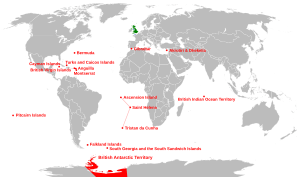
Britain still controls 14 territories outside the British Isles. These were renamed the British Overseas Territories in 2002. Some are uninhabited except for military or scientific staff. The others govern themselves to different degrees. But they rely on the UK for foreign relations and defense. The British government has said it will help any Overseas Territory that wants independence.
Some of these territories are claimed by neighboring countries. Spain claims Gibraltar. Argentina claims the Falkland Islands and South Georgia and the South Sandwich Islands. Mauritius and Seychelles claim the British Indian Ocean Territory. The British Antarctic Territory is claimed by Argentina and Chile. Many countries do not recognize any claims in Antarctica.
Most former British colonies and protectorates are now members of the Commonwealth of Nations. This is a group of 52 independent countries. It has about 2.2 billion people. Sixteen of these countries still have the British monarch, King Charles III, as their head of state. These include the United Kingdom, Australia, Canada, and New Zealand.
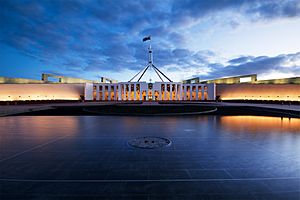
Centuries of British rule and migration have left a mark on these independent nations. The empire spread the English language around the world. Today, it is the main language for up to 400 million people. About 1.5 billion people speak it as a first, second, or foreign language.
The spread of English was also helped by the cultural and economic influence of the United States. The US was originally formed from British colonies. Except in Africa, where most former colonies use a presidential system, the English parliamentary system has been a model for many governments. English common law also influenced legal systems.
The British Judicial Committee of the Privy Council is still the highest court of appeal for some former colonies in the Caribbean and Pacific. British Protestant missionaries traveled worldwide. They spread the Anglican Communion to all continents. British colonial architecture can be seen in many cities that were once part of the empire. These include churches, railway stations, and government buildings.
Sports developed in Britain were also spread. These include golf, football, cricket, rugby, netball, lawn bowls, hockey, and lawn tennis. Some countries still use the British imperial system of measurement. Many former empire countries still drive on the left side of the road.
Political borders drawn by the British did not always match ethnic or religious groups. This led to conflicts in former colonies. The British Empire also caused large movements of people. Millions left the British Isles. The first settlers in the United States, Canada, Australia, and New Zealand came mainly from Britain and Ireland. Tensions remain between white settlers and native groups in these countries. There are also tensions between white minorities and native majorities in South Africa and Zimbabwe. British settlers in Ireland created divided communities in Northern Ireland. Millions of people moved to and from British colonies. Many Indians moved to Malaysia and Fiji. Chinese people moved to Malaysia, Singapore, and the Caribbean. After the Second World War, Britain's own population changed. Many people immigrated to Britain from its former colonies.
See also
 In Spanish: Imperio británico para niños
In Spanish: Imperio británico para niños




